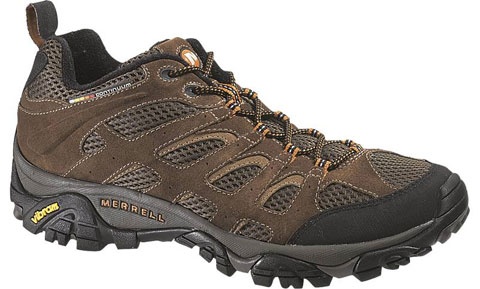From Sportfishing
Fish Report for 12-20-2016

Selecting hiking boots and shoes
12-20-2016
Jim Broshears
In order to be prepared to shop for hiking shoes or boots, you need to be able to answer the following questions. How are you going to use the shoe/boot? Do you want waterproof or ventilated? Do you want low, mid or high boot? Is your foot wide or narrow? And what size do you normally wear? Let’s start with how you plan to use the shoe.
♣ Trail running shoes are similar to running shoes or athletic shoes. They’re cut higher and have extra padding. They’re used for trail running or walking. The Salomon XA Pro 3D Ultra or XT Wings are good examples.
♣ Sandals are light and worn for ventilation. They should have adjustable solid straps and molded arch support. Use them during warm weather and on easy terrain. They’re great to carry with you and use when crossing brooks. The Keen Newport H2 handles the trail and the water very well. If you want to hike in a more open sandal the Chaco Z-1 is a good choice.
Class “A”
♣ Hiking shoes or trail boots (Class “A” to “B”) are the beginning-level hiking boots for maintained trails or smooth terrain. They are usually made of suede and nylon, are flexible, and have good support for the feet and ankles. Our best sellers in this category are the waterproof and the Keen Targhee II low and Mid or the ventilated Keen Voyager and Voyager Mid, the Merrell Moab Ventilator Mid and the Moab Ventilator low.
Class "B"
♣ Are mid-weight boots also known as Cross Hikers They are the classic hiking boot for moderate terrain. They are usually made of leather or tough synthetic materials and have a less flexible sole than the Trail Boot described below. In addition to the shoes and boots listed above, the Keen Glarus of Oregon PCT are a consideration here.
Class “C”
♣ Are off-Trail Boots made for rough terrain. They have toe caps and extra shock absorption. The Zamberlan 540 Rise GT or the Vioz GT fit the bill here as do the Asolo Flame GTX, Fugitive GTX and Powermatic 200 GV.
Class “D”
♣ Mountaineering Boots are for climbing major mountains. Use them with crampons. They have additional insulation for cold weather conditions.
Choosing between waterproof and ventilated is a puzzle to some people, especially when considering low-topped shoes. If this is your year round hiking shoe or boot waterproof is probably your best choice. They will be warmer in summer, if you primarily hike in summer, you might want to use a ventilated model.
Choosing the height of your hiker is again based on what you are going to use it for and how much protection your ankles need. If you plan to buy only one pair of hiking boots and use them in all conditions, a Voyager Mid is your best bet. I can imagine using my Keen McKenzie water shoes as light hikers but I can’t use them to snowshoe.
Your best value is to buy shoes for season. It is more expensive up front but because they will last longer, it will pay off in the long run.
Getting the right fit is a matter of trial and error. You really need to try on footwear to know if meet your needs. The highest rated boot on the market is a bad investment if it does not fit. A tried and true method for selecting the right size is to loosen the laces and push your foot all the way to the front of the shoe, you should be able to fit your index finger in the space between your heel and the back of the shoe. When you lace it up to snug, your foot should fill that space.
Your toes should not hit the front or top of the boot while walking, even on a steep downhill.
Make sure there is enough room in the toe-box of the shoe to wiggle your toes. Preferably the shoe will allow your toes to “splay” or spread a little as they would without shoes. This allows for better balance and circulation.
Here are some tips to avoid the pitfalls of hiking shoe purchasing.
1. Walk for at least 15-20 minutes before trying on shoes or try them on at the end of the day if you’ve been on your feet.
2. Don’t compromise because it’s a good deal, a bad fit is a bad deal.
3. Invest in quality footwear. I learned the hard way a long time ago, “cheaping out” on shoes and tires is a bad idea!
4. Wear them around the store for as long as you can. Some stores like ours will let you take them home and wear them indoors with a full refund if they don’t pass the muster.
5. Use a ramp and test walking both uphill and downhill.
6. If it feels bad in the store, it won’t get better later.
7. Don’t worry about the size on the shoe box, it’s the fit on your foot that matters.
8. Hotspots when you try them on will not improve with time.
Getting the right shoe or boot will is a worthwhile investment that will make your hiking experience more enjoyable.
Jim Broshears was born and raised in Northern California and has enjoyed the great outdoors in the State of Jefferson for over 50 years. Jim worked as a firefighter for 35 years and currently owns and manages Trailhead Adventures, an outdoor outfitter store in Paradise CA. Helping others enjoy the beauty of our amazing area is his passion. Jim co-manages a blog, hikingcampingstuff.com that is dedicated to providing information about hiking and backpacking gear, local adventures and tips on outdoor safety and survival.
< Previous Report Next Report >
More Reports

12-20-2016
Cow country coyotes are some of the best-schooled predators on four legs. Every day they observe the two-leggers walk the...... Read More

11-18-2016
Question: While looking through our trail cameras in a particular area this year, we’ve observed that roughly a third of...... Read More

Website Hosting and Design provided by TECK.net